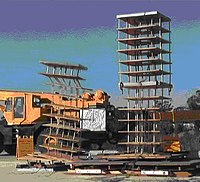
Photo from wikipedia
Abstract This paper develops a modelling strategy for the finite element analysis of perforated (arched) unreinforced masonry walls subjected to in-plane shear loading. An experimental baseline was used to facilitate… Click to show full abstract
Abstract This paper develops a modelling strategy for the finite element analysis of perforated (arched) unreinforced masonry walls subjected to in-plane shear loading. An experimental baseline was used to facilitate an accurate calibration and assessment of the chosen modelling strategy. This study provides the procedure and the results relevant to a stochastic assessment of unreinforced masonry shear walls. These results may be used in future studies of the reliability of these structures and may be applied in the calibration of reliability-based design practices. Utilising a two-dimensional micro-modelling approach, the capacity of a monotonic loading scheme to capture the envelope of a cyclically applied load was examined. It was found that, while the elastic stiffness of the laboratory specimens was overestimated by the finite element models, the peak load and global response was accurately recreated by the monotonically loaded models. Once the applicability of this procedure had been established, a series of spatially variable stochastic finite element analyses were created by considering the stochastic properties of key material parameters. These analyses were able to estimate the mean load resistance of the experimentally tested walls with a greater accuracy than a deterministic model. Furthermore, these analyses produced an accurate estimate of the variability of shear capacity of and the observed damage to the laboratory specimens. Due to the fact that the tested walls failed almost exclusively in a rocking mode, a failure mechanism highly dependent upon the structures’ geometry, the variability of the peak strength was minimal. However, the observed damage and presence of some sliding and stepped cracking indicates that the proposed methodology is likely to capture more variable and unstable failure modes in shear walls with a smaller height-to-length ratio or those more highly confined.
Journal Title: Engineering Structures
Year Published: 2021
Link to full text (if available)
Share on Social Media: Sign Up to like & get
recommendations!